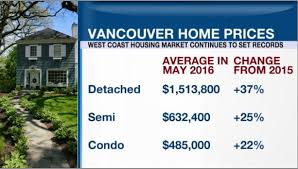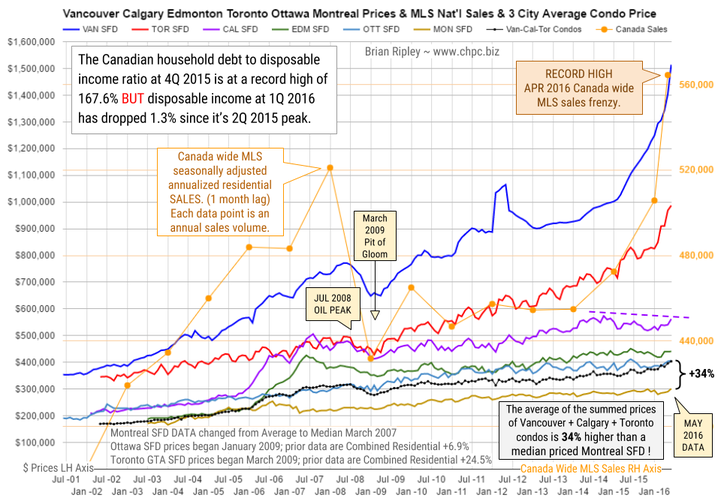Stocks & Equities
June 9, 2016, 6:52 AM:
Briefly: In our opinion, speculative short positions are favored (with stop-loss at 2,140, and profit target at 2,000, S&P 500 index).
Our intraday outlook is bearish, and our short-term outlook is bearish. Our medium-term outlook remains bearish, as the S&P 500 index extends its lower highs, lower lows sequence:
Intraday outlook (next 24 hours): bearish
Short-term outlook (next 1-2 weeks): bearish
Medium-term outlook (next 1-3 months): bearish
Long-term outlook (next year): neutral
The main U.S. stock market indexes gained 0.2-0.4% on Wednesday, slightly extending their short-term uptrend, as investors’ sentiment remained bullish. The S&P 500 index continues to trade along the level of 2,100. The nearest important resistance level is at 2,110-2,120, marked by April’s local high. The next resistance level is at around 2,130, marked by last year’s all-time high of 2,134.72. On the other hand, support level is at 2,100, marked by previous level of resistance. The next important support level is at around 2,070-2,085. Last year’s highs along the level of 2,100 continue to act as medium-term resistance level. Will the market break above these medium-term highs and continue its seven-year long bull market?
Expectations before the opening of today’s trading session are negative, with index futures currently down 0.2-0.4%. The European stock market indexes have lost 0.9-1.3% so far. Investors will now wait for some economic data announcements: Initial Claims at 8:30 a.m., Wholesale Inventories number at 10:00 a.m. The S&P 500 futures contract trades within an intraday downtrend, as it retraces its yesterday’s move up. The nearest important level of resistance remains at around 2,115-2,120. On the other hand, support level is at 2,100-2,105, among others. There have been no confirmed negative signals so far. However, we can see some short-term overbought conditions:
The technology Nasdaq 100 futures contract follows a similar path, as it retraces its yesterday’s advance. The nearest important support level is at around 4,500, and resistance level remains at 4,530-4,550, marked by recent local highs. The market extends its short-term consolidation following May rally, as we can see on the 15-minute chart:
Concluding, the broad stock market slightly extended its short-term uptrend on Wednesday, as the S&P 500 index got closer to its last year’s all-time high of 2,134.72. There have been no confirmed negative signals so far. However, we can see technical overbought conditions that may lead to uptrend’s reversal or downward correction. Therefore, we continue to maintain our speculative short position (opened at 2,093.94 – last Wednesday’s opening price of the S&P 500 index). Stop-loss level is at 2,140 and potential profit target is at 2,000 (S&P 500 index). You can trade S&P 500 index using futures contracts (S&P 500 futures contract – SP, E-mini S&P 500 futures contract – ES) or an ETF like the SPDR S&P 500 ETF – SPY. It is always important to set some exit price level in case some events cause the price to move in the unlikely direction. Having safety measures in place helps limit potential losses while letting the gains grow.
Thank you.

Anyone owning a SFD in the scorching hot Vancouver-Toronto market is sitting on an unredeemed lottery ticket.
In May 2016 Canada’s big city metro SFD prices all advanced M/M with the Vancouver and Toronto bulls posting new peak prices not only in the single family detached space but also in the townhouse and condo sectors as well. The national MLS sales volume also hit a new bizzaro high.
The chart above shows the average detached housing prices for Vancouver, Calgary, Edmonton, Toronto*, Ottawa* and Montréal* (the six Canadian cities with over a million people) as well as the average of the sum of Vancouver, Calgary and Toronto condo (apartment) prices on the left axis. On the right axis is the seasonally adjusted annualized rate (SAAR) of MLS® Residential Sales across Canada (one month lag).
…for a larger chart, more analysis and rental information go HERE
related: Vancouver’s Affordability Freak Show

 Understanding the New Competitive Landscape in a World of Significant Change.
Understanding the New Competitive Landscape in a World of Significant Change.
“Competition is on for discretionary dollars, as growth of real after-tax income of middle class Canadian families has stalled”
Mobile internet, combined with cloud technology, has enabled US mobile e-commerce (m-commerce) revenue to grow from $13.6B in 2011 to $155B in 2015, and is on track to grow at an annual rate of 28%. Amazon and Walmart now both offer free shipping and same day delivery in some cities. For businesses, Amazon Supply is quietly targeting the fragmented trillion-dollar US commercial and industrial B2B wholesale and distribution market.
Competition is also on for discretionary dollars, as growth of real after-tax income of middle class Canadian families has stalled, and grew by only 7% (0.2% per year) from 1976 to 2010. With globalization, capital has become more mobile, increasing income at the high end, driving the annual global demand for luxury goods to outstrip annual GDP growth by almost 50%.
Finally, technological substitution solutions are significantly disrupting entrenched competitors. Think of what Lyft and Uber are doing for on-demand car service, Google is doing for semi-autonomous vehicles, and Tesla doing to the traditional automotive sales, service and distribution value chain.
Your biggest competitor is not likely the traditional foe in your sector, but from e-commerce enabled global companies, competition for shrinking discretionary spending, technological substitution from new entrants, and existing players that are aggressively deploying technology to provide innovative low-cost and high-service solutions. Don’t be blindsided, be prepared.
Always operate from a strong base. Get your business fundamentals right, so you can grow from a strong base with a safety margin to withstand shocks. This includes scalable systems, access to capital, multi-channel business models, and solutions that serve an evolving market. Don’t leave anything to chance.
Plan to dominate, not just compete. Technology and globalization are massively expanding choice while lowering costs, so simply competing is no longer good enough. Intend to dominate your sector aggressively by building a strong market niche, selling globally, executing M&A options, innovating new product or service revenue streams, and owning the customer relationship.
Build a clear competitive advantage. Warren Buffet likes to buy companies that have a wide economic moat, i.e. a competitive advantage, such as low-cost production, brand name, or pricing power that enables a sustained market positon. Know your economic moat, and invest in it. If you don’t have one, figure it out quickly before your competition does.
Be fanatical about hiring service oriented staff. Hiring top talent is always a sure bet, however, opportunity is being created at the service-centric high end of the income scale, while Amazon is driving cost out of the low end. Make a service mindset a requirement for hiring all new staff. Cultivate a service culture at all levels.
Sell more, especially to your current customers. Make “More Sales” your mantra, and communicate its importance regularly. Ensure each employee knows and executes on his or her role in supporting sales. Start by selling more to existing customers, through new product and service offers, while constantly developing new markets that align with your unique value proposition. If you are the CEO, dedicate at least 50% of your time to new or existing customers.
Probe for flaws and then improve. Each day your competitors are planning to put you out of business, so you should think like them. Probe your systems for weaknesses and fix them immediately. For instance, failed employees are not failed people, but a failure in your leadership or system. Work on the business, as well as in the business, and embrace a continuous improvement philosophy.
While changes are shifting the competitive landscape dramatically, well-positioned, innovative and agile companies can leverage these changes to build a better company by being proactive, service oriented and innovative.
also from Eamon: 10 Easy Steps For More Cash Flow

The BIG question: Will the Federal Finance Minister yield to pressure and do something to stifle Vancouver’s real estate market? Damage Canada’s most dynamic economic sector by an extremely large margin. In 2015 Canada created 144,000 jobs of which 110,000 were in BC, mostly in construction related to real estate…much more to in Michael’s Mid-Week Update
 More from Michael: Time To Demand The Facts
More from Michael: Time To Demand The Facts

















